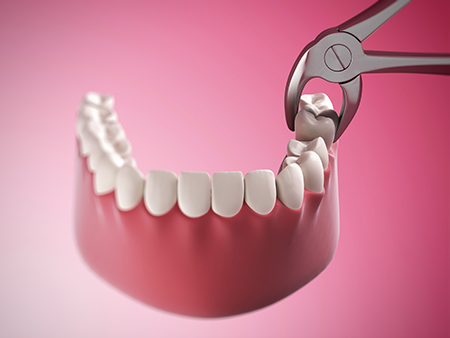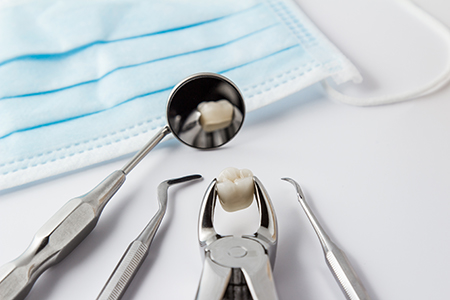
At the office of Callahan Family Dentistry, our first priority is protecting your long-term oral health. We always seek to preserve natural teeth whenever possible, but there are circumstances when removal is the most responsible treatment. In those cases, our goal is to explain the reasons clearly, plan care thoughtfully, and minimize discomfort for every patient.
Deciding on an extraction begins with a careful assessment of the tooth, the surrounding tissues, and your overall health. We review your medical and dental history, examine the area clinically, and supplement our evaluation with digital radiographs when needed. This lets us recommend the most appropriate next steps and anticipate potential challenges.
Patients tell us that understanding the rationale behind treatment helps reduce anxiety. We take time to discuss alternatives, expected outcomes, and whether tooth replacement will be part of the plan. When removal is advised, our team focuses on comfort, safety, and a clear roadmap for recovery and restoration where appropriate.
An over-retained baby tooth or a severely damaged primary tooth
Sometimes a deciduous tooth does not fall out on schedule because its root did not resorb properly or the tooth has fused to the jawbone. When that happens, the delayed loss can interfere with the eruption and alignment of the permanent tooth beneath it. In those cases, a strategic extraction can support normal development and prevent crowding or misalignment.
A permanent tooth that cannot be restored
Decay that progresses unchecked can compromise a tooth’s core structure or the nerve inside. When there isn’t enough healthy tooth remaining to support a reliable restoration, removing the tooth can prevent ongoing pain, infection, and damage to adjacent teeth or bone.
A tooth fractured beyond repair
Teeth can sustain complex cracks or breaks from trauma or long-term wear. If the fracture extends below the gumline or into the root in a way that prevents dependable repair, extraction may be the most predictable option to protect your function and comfort.
Advanced periodontal (gum) disease
When gum disease has severely reduced the bone and soft tissue supporting a tooth, the tooth may become loose or create an ongoing source of infection. In such advanced cases, extraction can stop further damage and make it easier to treat surrounding tissues.
Problematic wisdom teeth
Third molars often lack the space to erupt properly and may become impacted, decay, or affect neighboring teeth. Removing these teeth when they pose a risk to oral health is a common and often preemptive measure, particularly in younger adults.
Extractions as part of orthodontic planning
Occasionally, removing one or more teeth is the simplest way to create space for orthodontic tooth movement. When coordinated with an orthodontic plan, selective extractions can support improved alignment and a healthier bite.

Every extraction begins with a full evaluation and a conversation. We will review your medical history, current medications, and any conditions that could affect the procedure or healing. For some patients, coordinating with a physician or adjusting medications temporarily is an important safety step.
Digital radiographs are used as needed to visualize root structure, surrounding bone, and the position of nearby teeth. This imaging helps us determine whether a simple or surgical approach is necessary and whether referral to a specialist is the safest choice. We’ll explain the findings and answer your questions before any treatment is scheduled.
Comfort is a central concern. Local anesthesia is standard for extractions, and we can discuss additional options when anxiety or complexity warrants it. If sedation is appropriate, we will review what to expect, pre-procedure instructions, and how we monitor you throughout care to maintain safety and comfort.
A simple extraction is performed when the tooth is visible in the mouth and the root anatomy allows for direct removal. After numbing the area completely, the dentist gently loosens the supporting tissues and uses forceps to extract the tooth. The procedure is typically quick and recovery is often uncomplicated with proper home care.
Surgical extractions are necessary for teeth that are broken below the gumline, impacted, or otherwise obstructed. This procedure may involve a small incision, minimal removal of bone, or sectioning of the tooth to remove it safely. Depending on complexity, we may perform the surgery in our office or refer you to an oral and maxillofacial surgeon for care under specialized sedation or anesthesia.

Healing after an extraction is a process that benefits from clear instructions and realistic expectations. We provide tailored post-operative guidance that covers pain control, activity limitations, wound care, and signs to watch for during recovery. Most patients can manage discomfort with a combination of prescribed and over-the-counter medications and by following straightforward precautions.
Medications may include antibiotics when an infection is present or the patient’s health conditions indicate they are necessary. For pain, we discuss appropriate options and dosing so you can remain comfortable without overuse. Always follow the directions we provide and call if you’re unsure about any medication or symptom.
Because healing varies from person to person, follow-up appointments are scheduled when needed to check sutures, monitor the site, and plan any further treatment such as tooth replacement. We coordinate with specialists when an extraction is part of a larger restorative or surgical plan.
Maintain gauze pressure
Immediately after the extraction, bite gently on the provided gauze to help form a stable clot. Change the gauze as instructed and continue light pressure until bleeding has slowed. If heavy bleeding persists, contact our office for guidance.
Protect numb tissues
While local anesthesia is in effect, take care not to bite or irritate your lips, cheek, or tongue.
Follow medication instructions
Antibiotics:
If prescribed, take the full course exactly as directed to reduce the risk of infection.
Pain relief:
Begin pain management as recommended to stay ahead of discomfort. Use any prescription medicines only as directed and combine them with over-the-counter options if advised.
Protect the blood clot
Avoid rinsing vigorously, spitting, or using a straw for the first day or two to prevent dislodging the forming clot.
Use ice to control swelling
Apply an ice pack to the cheek near the extraction site intermittently during the first 24 hours to reduce swelling and discomfort.
No smoking
Tobacco use impairs clot formation and delays healing, so avoid smoking and nicotine products during the initial recovery period.
Choose gentle foods
Stick to soft, cool, or lukewarm foods for the first couple of days and avoid anything hot, crunchy, or spicy until healing advances.
Maintain careful oral hygiene
Keep the mouth clean by brushing gently and rinsing with a mild saltwater solution when advised. Avoid disturbing the extraction site while it is forming a stable clot.
Attend your follow-up
If sutures were placed or additional monitoring is required, be sure to keep your scheduled appointment so we can confirm proper healing and discuss next steps.
If you notice persistent bleeding, increasing pain, swelling that worsens after a few days, or any other unusual symptoms, contact our office for further instruction and evaluation.

Removing a tooth can create the opportunity to improve overall oral health and function. When replacement is appropriate, we discuss the full range of options so you can choose what fits your needs and timeline. Common solutions include removable partial dentures, fixed bridges, and dental implants.
Fixed bridges and removable prostheses can restore appearance and chewing ability relatively quickly in many cases. Dental implants, when suitable, provide a long-term solution that closely mimics a natural tooth’s support and function. Each option has different clinical considerations, and we tailor recommendations based on your bite, bone health, and restorative goals.
Coordinating extraction and replacement often involves planning for bone preservation or grafting when needed to ensure the best long-term outcome. We’ll outline a sequence of care and any additional procedures that may improve stability and esthetics before moving forward with definitive restoration.
Patients come to our office because they want clear communication, thoughtful planning, and gentle clinical technique. Our dentists have the training and experience to evaluate complex cases and to coordinate specialist care when a referral offers the safest pathway. We emphasize compassion and respect throughout treatment so patients feel supported from diagnosis through recovery.
Whether your case is straightforward or requires more advanced surgical management, we work with you to develop a care plan that considers comfort, overall health, and long-term function. When necessary, we collaborate with oral surgeons and other specialists to ensure high-quality outcomes and a smooth recovery process.
If you have questions about extractions, what to expect during the procedure, or which restoration might be best for you, please contact our office for more information. Our team is available to help you understand your options and plan a course of care that protects your oral health and restores confidence in your smile.
The most common reasons for tooth loss include advanced periodontal disease, extensive tooth decay, and facial trauma. According to statistics, gum disease is responsible for close to 70% of tooth loss in adults. Although less frequent than the preceding three reasons, it should also be noted that specific diseases, drugs, smoking, and poor nutrition contribute to the risk of tooth loss.
The Centers for Disease Control and Prevention report that in the United States, an average of 12 teeth (including the wisdom teeth) are lost by the age of 50. Also, 26% of adults between 65 and 74 years of age have lost all their teeth.
Every patient and every situation is different. However, when a tooth and the surrounding tissues are numbed with a local anesthetic, you should only expect to feel a bit of pressure, but no pain as the tooth is being loosened from the surrounding tissues and extracted. For patients who are apprehensive and for some surgical extractions, our office will discuss our options in dental sedation to provide further relaxation and reduce any sense of discomfort.
While it's normal to feel some tenderness and swelling following an extraction, the degree of these sensations can vary. It mostly depends on the complexity of the extraction and the body's response to the procedure. We'll recommend or prescribe the appropriate pain medication to help ensure your comfort and give you specific instructions for maximum effectiveness and safety.
Typically, the recovery period following a simple extraction is shorter than a surgical extraction. However, a patient's overall health, habits, the size and location of the tooth, and other variables can influence recovery and healing. To speed up the recovery and avoid any complications, patients must follow the given at-home instructions diligently. We'll carefully review what to expect following your procedure and go over your post-op instructions.
Smoking interferes with blood clot formation, which is an essential first step in the healing process. Blood clot formation not only provides a protective layer to cover the underlying exposed bone and nerve endings, but it also supports the growth of new tissue. Cigarette smoke also contains chemical toxins that can disrupt the healing process and lead to problems such as continued inflammation, infection, or dry socket.
In a very small percentage of cases, a condition known as dry socket can develop in the aftermath of a dental extraction. This painful condition can arise when the blood clot in the extraction site doesn't form properly or gets dislodged. With dry socket, you may experience throbbing pain and symptoms such as bad breath and an unpleasant taste in your mouth. As skilled providers of care, our office will provide immediate treatment to alleviate your discomfort and promote healing.
The last teeth in your mouth to develop, wisdom teeth often do not have enough room to fully erupt or may be positioned in the wrong direction. These issues can affect your dental health as well as overall wellbeing. While some individuals never develop all their wisdom teeth, and a few have sufficient space for them, there are many people with partially or fully impacted third molars. Our office will monitor the development, position, and health of your wisdom teeth and will advise you if and when extractions are indicated.
After a tooth is removed, bone-grafting material is sometimes placed in the socket to promote healing and encourage new bone development. This procedure is often performed to support the eventual and successful placement of a dental implant.
At the office of Callahan Family Dentistry, we strive to make dental care affordable and accessible. Depending on the type or complexity of the extraction and other variables, the cost of the procedure can vary. Based on our diagnostic findings, our office will inform you of the healthiest choices in care, explain the fees, discuss insurance coverage, and explain your payment options.
Many dental plans offer some level of coverage for tooth extractions. We'll advise you if your plan covers the full cost of the procedure and if there is any out-of-pocket expense. Our business office will work with you to maximize your insurance benefits as much as possible while helping you minimize any out-of-pocket expenses.
Our goal is to help every patient experience the benefits of good oral health and a beautiful smile. We value the trust you have placed in our office and strive to provide solutions that meet your dental needs and expectations of care.
